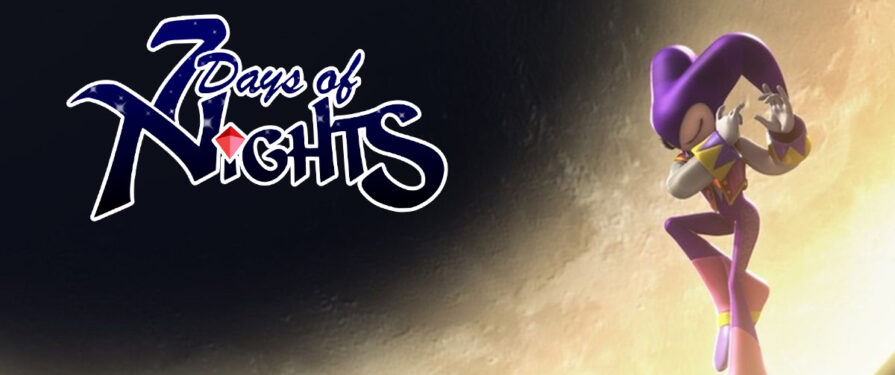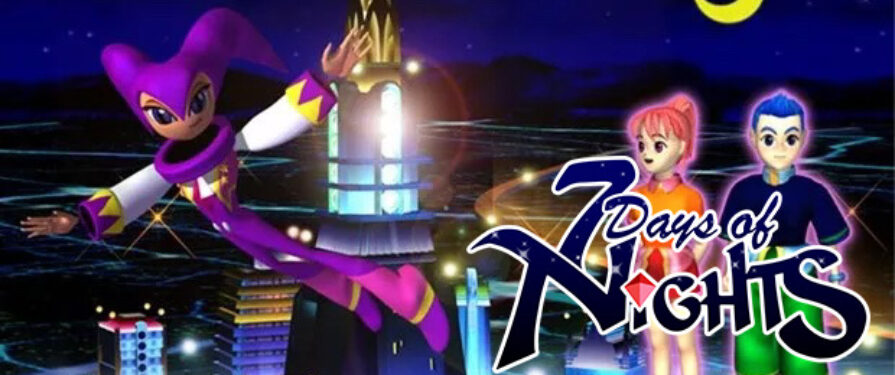For Part 1 of this article, go here.
The Cameos
Though no new NiGHTS game was on the horizon by the late 90s, Sonic Team and SEGA still had plenty of love for the purple dream jester, and they demonstrated that a lot. Sonic Adventure featured an entire NiGHTS themed pinball table, which likely served as many Sonic fan’s first exposure to the character. When Dreamcast party game Sonic Shuffle’s multiplayer was played on December 24, NiGHTS replaced Lumina. Sonic Adventure 2 featured NiGHTS on numerous level assets and featured a chao based on them. The cameos continued even after the Dreamcast.
Sonic Pinball Party gave NiGHTS a second pinball table, and the character was playable in both the Sonic Riders games and SEGA Superstars, a mini game collection for the PS2’s Eyetoy. NIGHTS popped up in Billy Hatcher as a special unlockable character, and also starred in NiGHTS Score Attack, a special mini game that could be downloaded to the GBA over a link cable from both Billy Hatcher and Phantasy Star Online.
For over a decade, this was essentially how NiGHTS stuck around. It wouldn’t be until 2007, eleven years after the original game’s release, that this finally changed.
The Sequel
Takashi Iizuka had often talked about wanting to do a NiGHTS sequel, and finally got his chance in late 2005, after the completion of Shadow the Hedgehog. My mid-2006, NiGHTS Journey of Dreams was in full production for the Wii. Though some have speculated JoD may have been originally planned for HD consoles, Iizuka later confirmed it was built from the ground up for Nintendo’s system.
After a small delay, JoD launched in December of 2007. It would not be as well received as its predecessor, receiving mixed-to-positive reviews. The game also likely didn’t sell especially well, though sales numbers appear to be hard to confirm.
JoD kept several aspects from the original, including its 2.5 perspective, its focus on flight, the timer for NiGHTS, and the ability to link rings and blue chips together for higher scores. Unlike the previous game, players needed to chase down nightmarens riding large birds in order to collect keys to free NiGHTS, and there is no incentive to run the timer down. Instead, JoD encourages players to simply complete its stages as quickly as possible.
JoD also introduced a lot of brand new features, such as multiple missions per level, a significantly more fleshed out plot, an online multiplayer mode, and most infamously, platforming levels starring the children. It also has an area where Nightopians can be interacted with called “My Dream,” which is essentially a barebones chao garden. This open space can be filled with random objects from the game’s levels, as well as Nightopians and Nightmarens, which are sent here via paralooping.
JoD does a lot to try to modernize NiGHTS. While it has the same number of levels as its predecessor, it stretches those levels out by giving each five missions that reuse assets, including the aforementioned platforming sections. It also features loads of cutscenes and voice acting for all the characters.
JoD’s plot is essentially a reboot of the previous game, but with new kids: Helen and Will. The game features a new helper character, “Owl” who essentially serves the same purpose as Tikal and Omochao. Aside from NiGHTS, Wizeman and Reala also make a return. Everyone is sporting new, more complex designs.
There is a lot I could say about JoD, but that’s best left for another article. To this day, it continues to serve as the only other full game in the NiGHTS franchise. It would not be the last NiGHTS game released, however. The original would soon be getting a remake.
The Remake
Just a few months after the launch of JoD, SEGA launched a full remake of the original NiGHTS for the PS2, exclusively in Japan in February of 2008. It featured completely remade visuals, Christmas NiGHTS, and a complete port of the Saturn original. Each copy of the game also came with a second printing of the rare NiGHTS story book. The PS2 version featured additional timed events in Christmas NiGHTS, including special summer and Halloween outfits for Claris and Elliot, and a special Halloween skin for NiGHTS. Unfortunately, the game didn’t sell particularly well, charting just over 6,000 units. The remake version of the game is also infamous for featuring somewhat slower speeds, as well as inferior (potentially 8-way directional) control instead of full analog.
This version would later become the basis for the HD remake, which as released on Xbox 360 and PS3 four years later in 2012. This remake presented NiGHTS in HD for the first time, and featured true 16:9 widescreen as opposed to the stretched 4:3 widescreen of the Saturn and PS2 games. It included all the special features of the PS2 version, as well as all the control issues. These issues would later be patched, though.
NiGHTS into Dreams… HD continues to be available for both Xbox and Steam users, and can also be played by anyone who has Game Pass or PS Now, making it far more accessible then it once was.
The Legacy

NiGHTS hasn’t had a single release of any sort in nine years, but as with before JoD, the character hasn’t disappeared.
NiGHTS was a playable racer in 2012’s Sonic & All-Stars Racing Transformed, and inspired a whole DLC level in 2013’s Sonic Lost World. NiGHTS, Reala and Wizeman all returned to Archie as part of their World’s Unite crossover event. They appeared as “buddies” in 2015’s Sonic Runners, and inspired a costume in 2017’s Sonic Forces. Elements from the games even popped up in Sonic’s 30th Anniversary Comic and orchestra just last month!
Finally, NiGHTS as a brand has recently made a return…as a slot machine in certain casinos. I can’t say I’m exactly happy about that, but it does show that someone somewhere still sees value in NiGHTS as a franchise.
With Iizuka expressing an interest in returning to NiGHTS yet again, there is yet hope that we’ll be seeing the purple dream jester again in a proper game. Until then, we’ve still got 25 years of games and legacy to remember them by.






















































